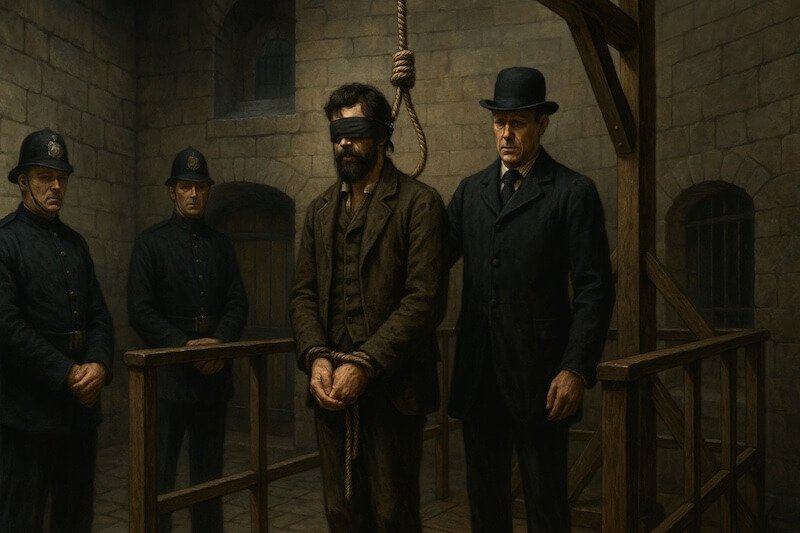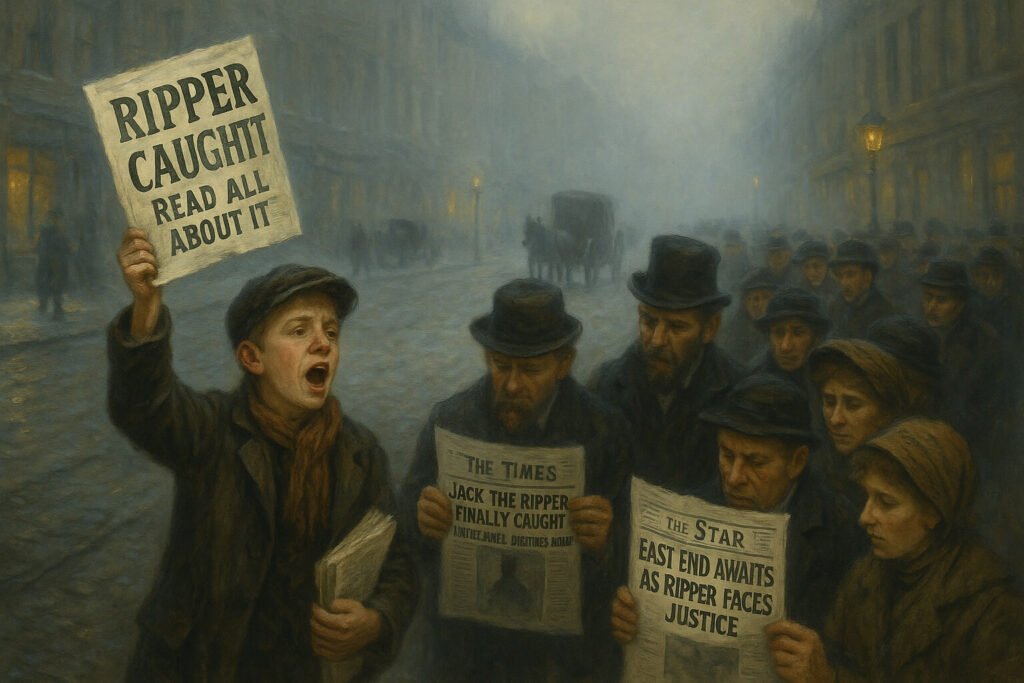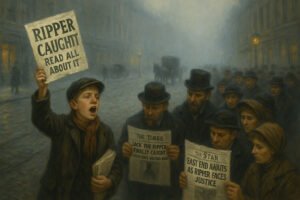It’s a frosty January morning in 1889, and London starts to stir beneath a veil of soot-stained fog. On a street corner in Whitechapel, a paperboy stands shouting, “Ripper caught! Read all about it!”, struggling to make his unbroken voice heard above the din of passing carriages.
A crowd starts to swell around him, desperate for confirmation, for closure, to see the news they’ve been waiting for with their very own eyes. The headlines that greet them are met first with relief, then excitement. Each of the city’s dozens of newspapers—from The Times and The Illustrated Police News to the Ripper-obsessed The Star and The Evening News—exhibits bold front pages with larger-than-life illustrations, conveying messages that vary on the same theme:
“Jack the Ripper Finally Caught: Whitechapel Breathes Again”.
“East End Awaits as Ripper Faces Justice”
By lunchtime, the Ripper’s incarceration is on the lips of every Londoner, the subject of conversation in every pub from the Ten Bells in Whitechapel to the Prospect of Whitby in Wapping. “They’ve got him—swear it on my life—locked up in Leman Street right now,” an already tipsy punter tells an already inebriated crowd for the sixth time that day. Another nods knowingly: “Saw the bill posted outside Mitre Square this morning. If you ask me, he’ll be standing before the judge before the week is out.”
But would he? What would have happened if Jack the Ripper had been caught? Would he have swung from the gallows? Been locked away in Bedlam? Paraded before the press like a grim trophy, or a triumphant symbol of the power of London’s Metropolitan Police? Let’s step back into 1888 and explore the chilling reality of what awaited murderers in the Victorian Age, and what might have happened had history’s most infamous serial killer been brought to justice.
Swift Justice at the Gallows?
Despite the growing demand for reform in the application of the death penalty, in the late 19th century, there was little ambiguity in the British legal system when it came to murder. The punishment was death. Plain and simple.
Since 1861, capital punishment had been the penalty for five heinous crimes: murder, treason, espionage, arson in the royal dockyards (an area of considerable importance to the British Empire, which derived much of its wealth from maritime commerce), and piracy with violence.
Had Jack the Ripper been arrested, charged, and convicted, he would have faced the noose. Public executions had ended in 1868, with the abolition of beheading and quartering coming into force two years later, so he wouldn’t have swung before a jeering crowd. Instead, Jack the Ripper would have met his fate within the stone walls of Newgate Prison, under the sober supervision of a government executioner.

Victorian hangings were swift, scientific, and disturbingly routine. Executioners like James Berry and William Marwood refined the “long drop” method to ensure instant death by breaking the neck. The short drop, which left a victim to suffocate sometimes for several minutes, had long been regarded as inhumane. But get the long drop method wrong and the weight of the victim could result in decapitation. Far too savage for a Christian society.
But although hanging had been “perfected” to ensure as swift an end as possible, the executioners responsible for enacting it suffered greatly in their work. Some—like Berry—penned memoirs in which they described emotional turmoil and deep regret after carrying out their duties. Even so, the state had little room for sentiment. Commit murder, and you would hang.
What if the Ripper Been Declared Insane?
In one timeline, the day after the blindfolded Ripper dropped beneath the gallows, Londoners rush to buy the morning paper, fresh off the press. They breathe a collective sigh of relief at the title: “Jack Brought to Justice: the Butcher of Whitechapel Hanged.”
In another, however, Jack the Ripper does not meet such a swift—and some would say merciful—end. Even in Victorian times, the insanity defence was legally recognised. And given the brutality and ritualistic nature of the Ripper’s canonical crimes, a clever barrister might have made the case for diminished responsibility. “Such gruesome acts”, he might argue, “could only have been committed by a man not in control of his mind.”

Such was the argument brought forward by the defence counsel of one Michael Stokes, a soldier stationed in York in the 1880s, who one day, without warning, crossed the barracks room and shot a visiting wife dead in front of her husband.
But history shows us the courts were far from sympathetic. Although there was no clear motive, and Stokes’ defence argued that the crime’s senselessness—the lack of concealment, escape attempt, or reason—was in itself proof of insanity, the judge did not agree.
“Who enabled them to dive into the human heart,” he asked, “and see the real motive that prompted the commission of such deeds?” In this instance, reason prevailed over speculation; the application of punishment over the administration of psychiatry. Stokes was convicted and hanged in York that very same year.
Had Jack the Ripper stood in the dock, his madness might have been debated. But it almost certainly wouldn’t have saved him, such was the gravity of his crimes.
Others Who Hanged for Similar Crimes
Jack the Ripper was not the only man in the Victorian era to commit horrendous murders—nor would he have been the only one to hang for them. Frederick Deeming, known as “the closest thing Australia had to a Jack the Ripper”, and even a suspect in the Ripper case, was accused of having murdered his wife and children in England and buried them beneath the floorboards before going on to kill another wife in Australia. He was hanged in Melbourne in 1892.
Thomas Cream, a convicted serial poisoner, also met his end on the gallows in 1892. Cream famously claimed responsibility for the Ripper murders, and was perhaps even more famously interrupted mid-sentence by the hangman pulling the lever. William Bury, another suspect in the Ripper murders, who had lived in Whitechapel during the spree of 1888, confessed to murdering his wife and mutilating her body in Dundee. He was executed in 1889.
Nor was capital punishment reserved only for men found guilty of committing the most heinous crimes. Amelia Dyer, one of Britain’s most prolific serial killers, was convicted of murdering infants in her care, earning her the disturbing moniker the “baby farmer.” Her victims may have been very different, but the public horror and press frenzy around her reflected the Ripper case, and the fate she met in 1896 would likely have mirrored his.
What if Jack the Ripper Were Caught Today?
Suppose Jack the Ripper committed his crimes not in 1888, but in 21st-century London, stalking the streets of Whitechapel and Spitalfields and with a scalpel.
He would not face the death penalty—the UK abolished capital punishment in 1965. But he would face life behind bars, and likely never see freedom again. In cases of extreme violence, judges can impose a whole life order—a sentence with no possibility of parole. Such was the punishment deemed fit for the crimes of Peter Sutcliffe (the Yorkshire Ripper), Levi Bellfield, and Rose West. Jack the Ripper would almost certainly join their ranks.
If he had been diagnosed as criminally insane, the Ripper would likely be sent to Broadmoor or Rampton, two of the UK’s most secure psychiatric institutions. But make no mistake: he would never walk free.
Closing Remarks
If Jack the Ripper had been caught in 1888, he almost certainly would have been hanged, his identity no longer the stuff of legend but a grim statistic in the historical record. If caught today, he would rot in a maximum-security facility, studied, dissected, and stripped of all myth.
But Jack the Ripper was never caught. And that’s why he lives on—not in flesh and blood, but in whispers down dark alleys, in the yellowing pages of police files, and in the morbid curiosity of those who walk the very streets he once stalked.
Curious to learn more? Join us on the ultimate Jack the Ripper Tour through Whitechapel and discover the facts, the theories, and the chilling truths behind history’s greatest villain and, most importantly, the stories of his victims: the people behind the names.








